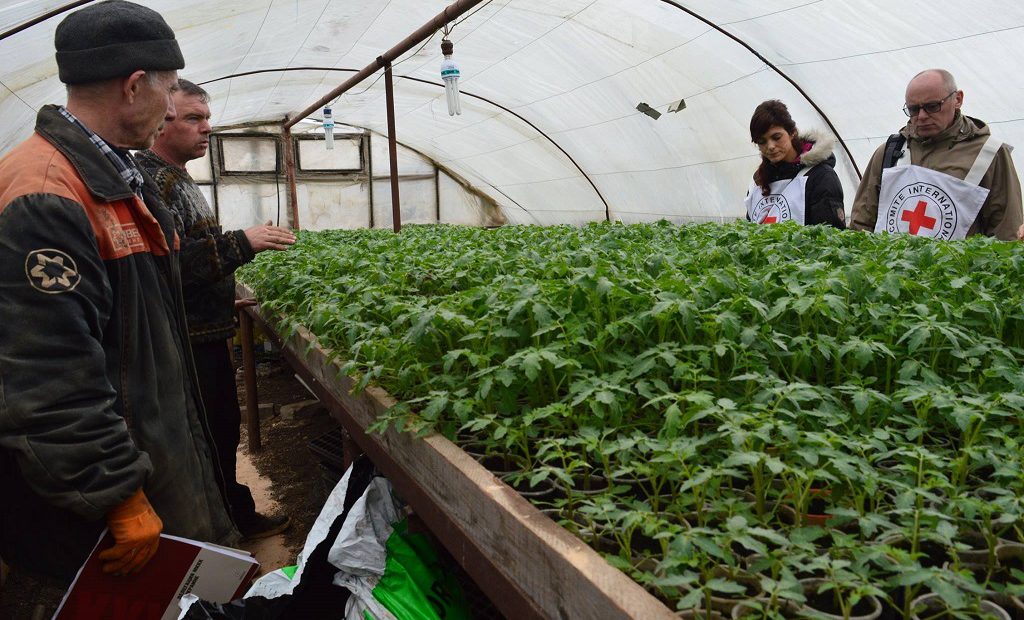Jo implemented the ICRC’s Economic Security programmes in Ukraine from February 2016 until early May 2017, managing 45 staff. In this interview, Jo explains how the ICRC helps people affected by the conflict in eastern Ukraine.
What are the key programmes that you are working on?
We have a number of different programmes. One offers direct support with food and hygiene items on a monthly basis to those affected by the conflict who live on each side of the contact line. This helps them prioritize their income to cover other expenses, such as health care.
During last winter we supported more than 10,000 families, providing them with fuel, warm clothing, blankets, plastic sheeting and cash assistance to cover electricity and gas bills. For example, in Opytne village, Donetsk oblast, due to the conflict there is no electricity at all. Now local residents use the ICRC fuel vouchers to ensure public generators’ work, which helps to resume electricity and charge the phones. The gas vouchers are used to fill gas burners (also provided by the ICRC) and ensure cooking.
In addition, we distributed animal feed to help families maintain their livestock through the winter.
In 2016 we began switching to cash assistance where there are functioning markets and financial service providers. When people have access to markets they can make choices about how they want to use the money they receive. The cash assistance programme provides 660 Hryvnia per person and is delivered to the participating families each month by bank transfer. We calculated this amount on the basis of the minimum expenditure on a range of basic items, and the average income of the programme participants. The ICRC covers the gap between the two. We review the amount every three months and adjust it accordingly.
On the non-government controlled side, we also support orphanages, nursing homes, medical centers and other entities, where people are long-term residents. We provide these institutions with food, hygiene items, blankets, and bed sheets to improve people’s living conditions.
In addition we have been supporting schools on both sides of the contact line. For example, we conduct mine-risk education sessions with the students, reinforce the school’s windows, and refurbish the basement so that it can be used as a shelter. We supply the schools with torches, mattresses and jerry cans. We know a school on the contact line where teachers take children to the basements saying them: “We’re going to the secret magic room”. When the shelling starts, the children and other community members need a safe and equipped space to go.
Since 2016, we provide direct support to households in order to avoid a dependency on relief. We support people as much as possible in the areas where there is a certain level of stability, and help them move from relying on relief to starting independent food production and income generation. In April this year, we helped to install a total of 52 greenhouses with irrigation systems in Krymske, Bolotene and Syze villages, Luhanks oblast, and provided the beneficiaries with seeds and fertilizers, so that they can become self-sufficient and maintain their families.
As well, we are exploring ways for people to access markets and employment opportunities more easily. For example, in Iasynuvata district in Donetsk oblast where several villages were cut off from the transport services we negotiated with a transport company to start operating there. Now about 2,000 passengers are using the bus 3 times a week, which is connecting Ocheretyno village with the markets and other villages. We will subsidy the transport costs until people are able to pay for themselves.
Also looking at job creation, focusing on small and medium size enterprises, we help recapitalize ailing businesses to get them back on track and can also pay salaries for the first six months. This mechanism, developed by our teams, enables companies involved in the programme to rehire their former workers or employ new ones to get their businesses functioning again on a sound footing and thus be able to provide their employees’ salaries themselves in the longer term. We have a successful example in Hranitne village, Donetsk oblast, where we helped the local residents to buy the details for tractor repair and workwear for people, which organize disposition of garbage from the village. During the several years of the conflict this issue had been unsolved, but now the garbage is regularly taken out of the village and the local community supports the work of the working team.
This job creation project is innovative for the ICRC and we are piloting it in Ukraine. If it is successful, we will replicate it to other contexts around the world where we work.
What does the ICRC plan to achieve by the end of 2017?
We would like to focus on a more seasonal approach, when people need support the most; for example in winter when it is cold and people’s electricity and heating bills go up leaving them with less money available for other necessities. So our relief programme will be more responsive to such issues, and target the most vulnerable at the right time. It will also still respond to changes in the conflict that affect people’s ability to support themselves.
Finally, I would like to see a successful implementation of our job creation scheme and other pilot projects. We want to make sure that people can get back to work and support themselves, and we will monitor our success in this endeavor so as to learn how to do something similar on a bigger scale in 2018.

